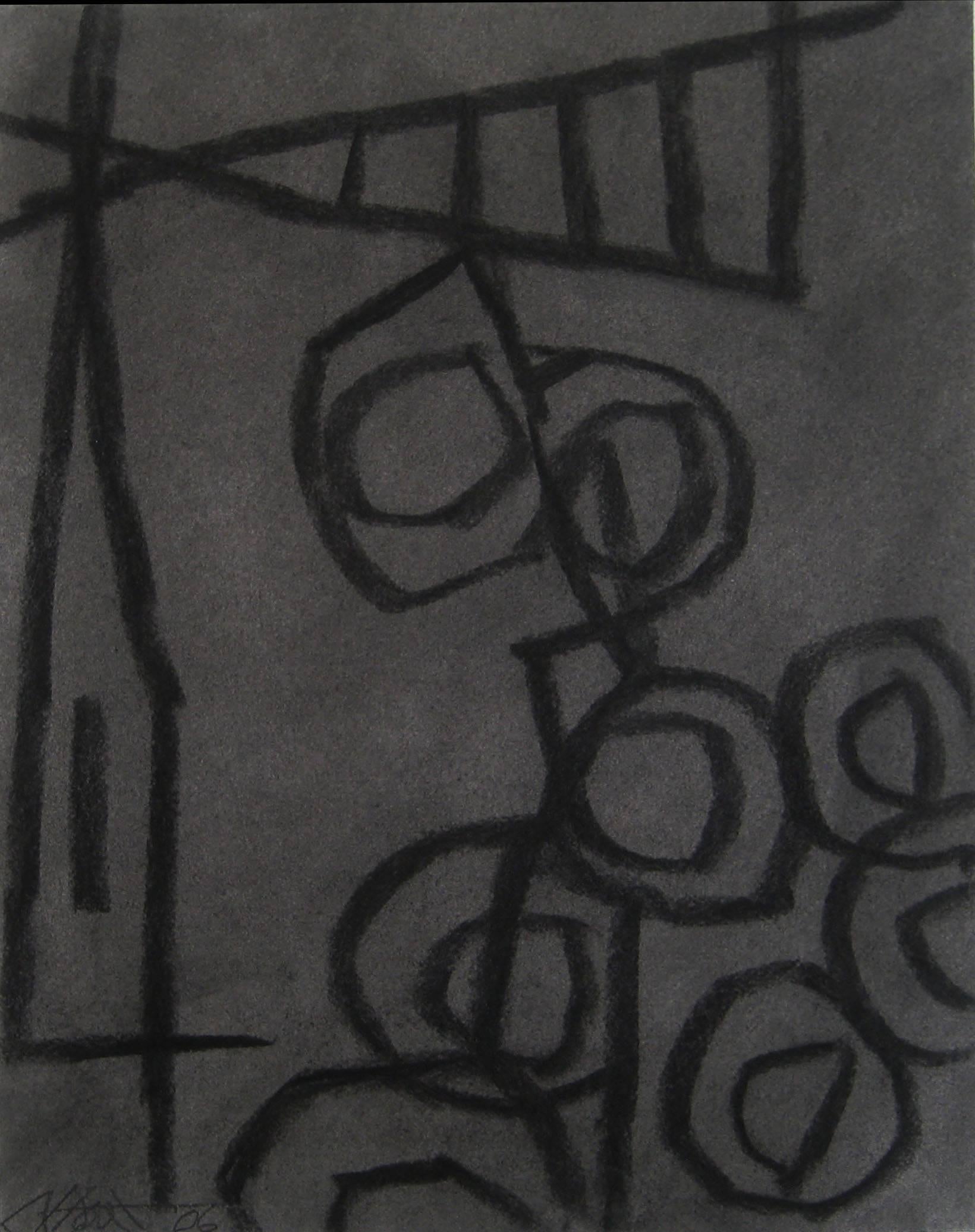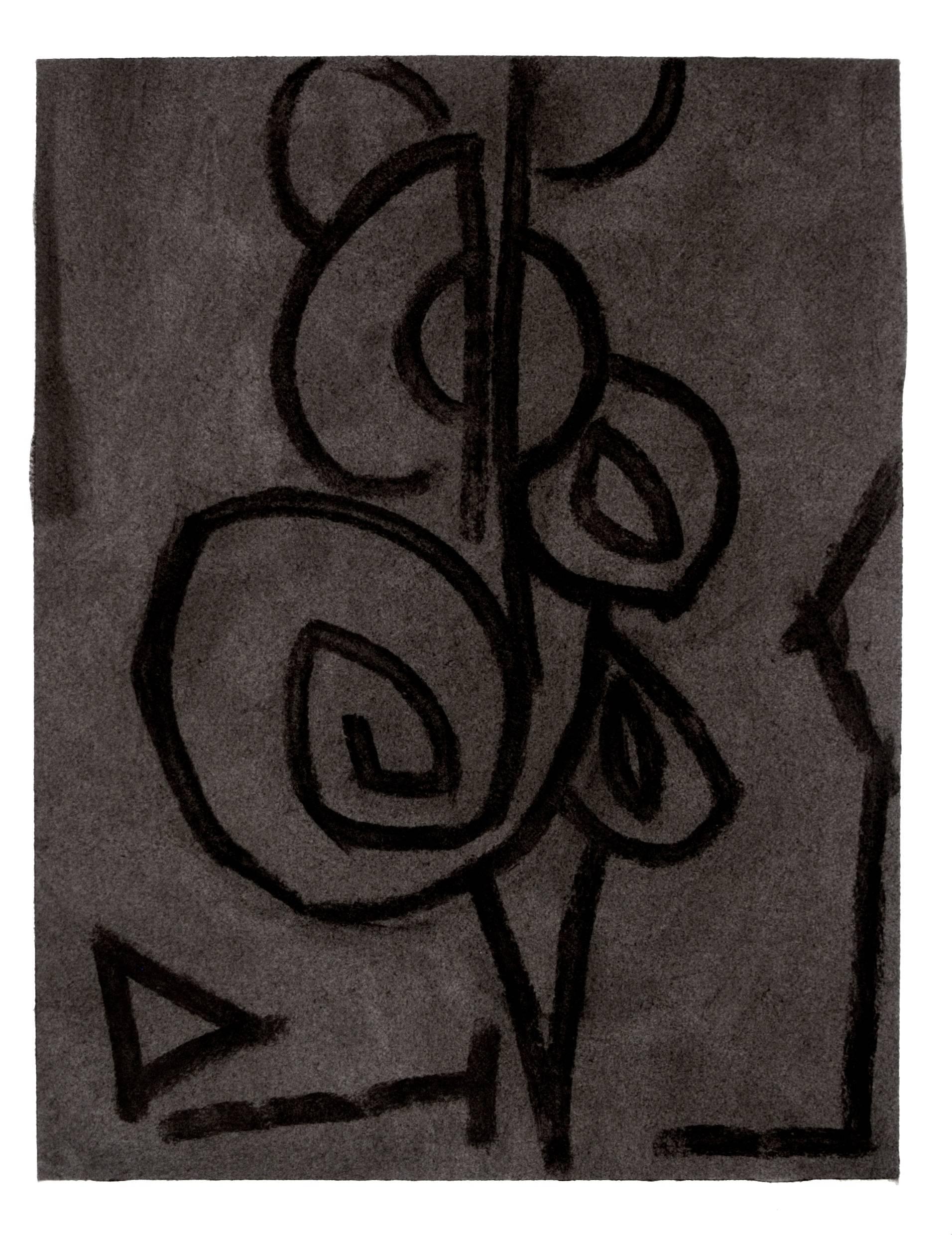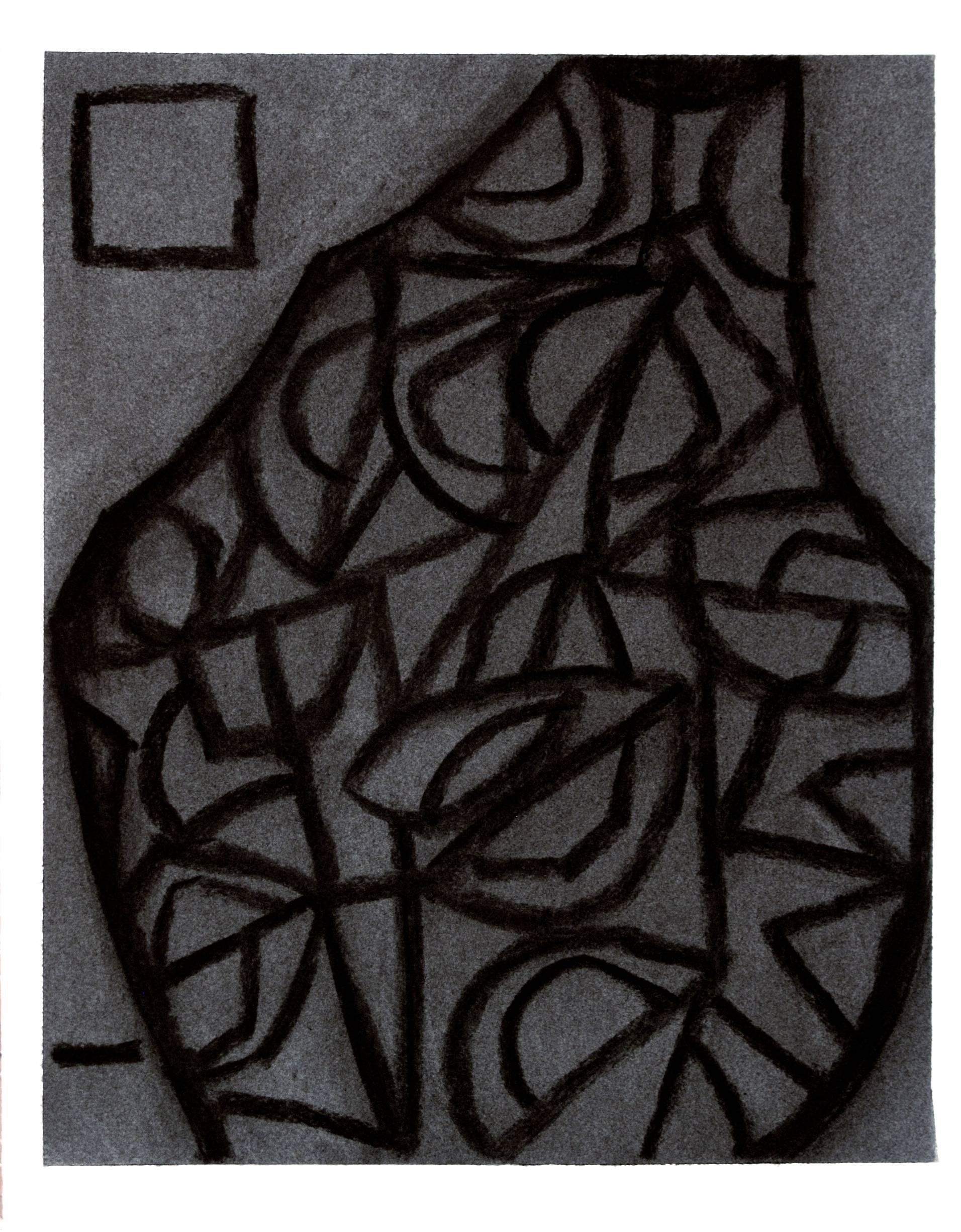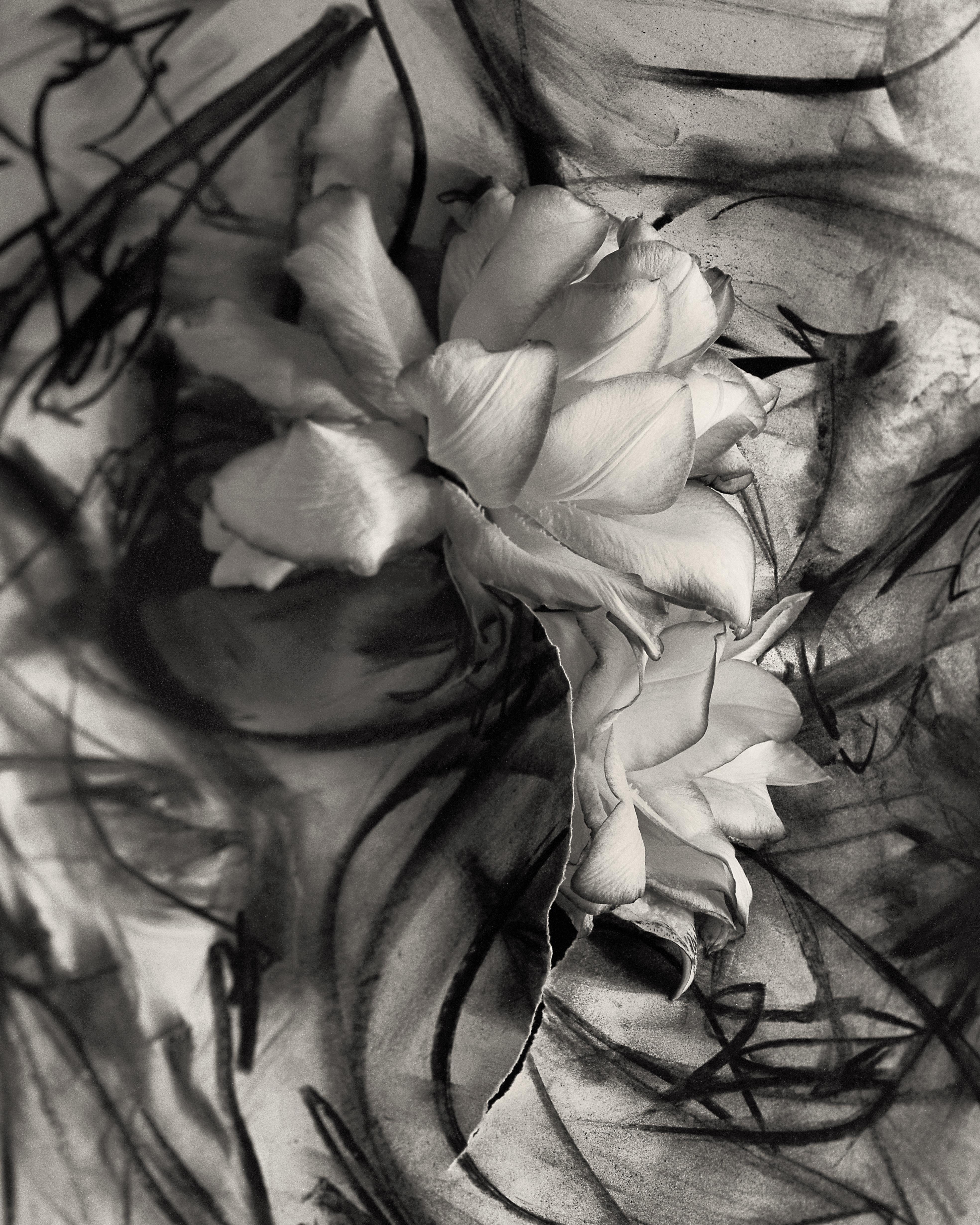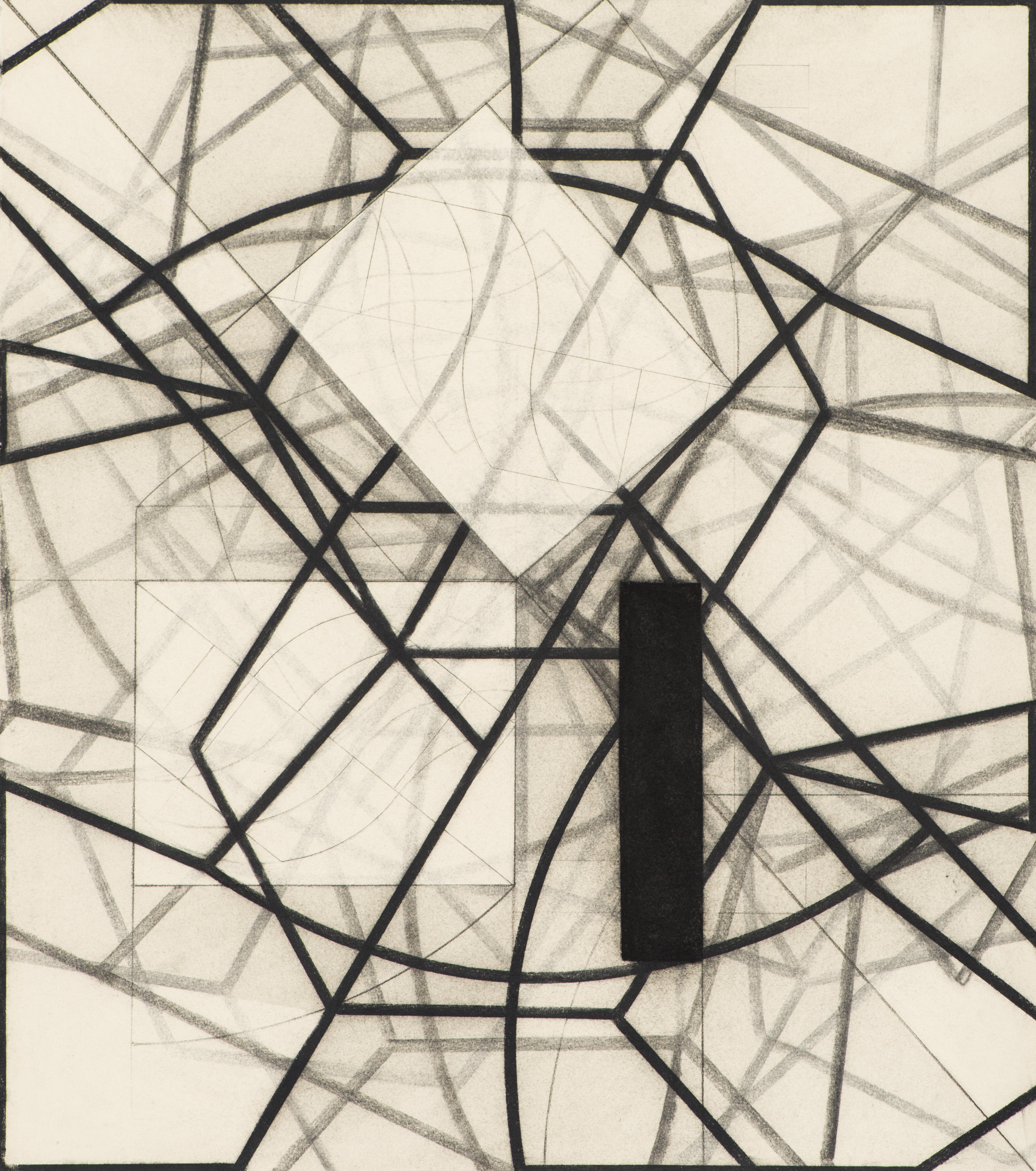Items Similar to 1950s Abstract Charcoal Drawing, Mid Century Modern Design, Black Off White
Want more images or videos?
Request additional images or videos from the seller
1 of 15
Ludwig R. Sander1950s Abstract Charcoal Drawing, Mid Century Modern Design, Black Off WhiteCirca 1955
Circa 1955
About the Item
Circa 1955 abstract charcoal drawing on paper signed by artist Ludwig R. Sander (1906-1975). Presented in a custom frame measuring 32 x 42 x 1 1⁄4 inches. Original drawing measures 21 x 31 1⁄2 inches.
Drawing is in very good condition - please contact us for a detailed condition report.
About the Artist:
Born 1906 Staten Island, New York – Died 1975 New York City
The son of a musician, Ludwig Sander was exposed to art as a youngster through visits to the Metropolitan Museum and reproductions of Art Nouveau and the Jugendstil in the Manchester Guardian and in German magazines to which his parents subscribed. Having studied architecture and architectural drawing in high school, he entered New York University in 1924, but left two years later to become a painter. In 1927 he took a four-month trip to Europe, returning to New York for independent study with Alexander Archipenko before entering the Art Students League in 1928 where he studied until 1930 with George Elmer Brown, Edward McCarten, Cecil Chichester and Boardman Robinson. Sander also attended the League’s summer school in Woodstock, New York, where he met Ernest Thurn, who with Vaclav Vytlacil previously studied with Hans Hoffman in Munich.
Sander did not study with Vytlacil at the League because in his mid-twenties he felt "so damn cocky [that] there’s nobody going to teach you anything, but it’s nice to know them." Nonetheless, Vytlacil encouraged him to study with Hoffman in Munich in 1931-32. Hoffman influenced Sander to break away from ideas he had acquired about drawing from the figure and the landscape. During his time in Europe, Sander sublet Vytlacil’s Paris studio when he helped run Hoffman’s summer class in Capri. After returning to New York from Europe in 1932, Sander began painting in a referential abstract style different from his later and more widely known geometric work. He joined the American Abstract Artists established in New York in 1936 as a forum for the discussion and debate of abstract art and to provide exhibition opportunities when few other possibilities existed.
During World War II he enlisted in the United States Army in 1943 working in the German Intelligence Section in Europe, achieving the rank of Staff Sergeant. After the war he re-established himself in New York, initially reviewing art books for The Saturday Review of Literature. In 1949 he co-founded The Club, an association and discussion group for artists in New York whose sixteen members included Willem de Kooning, Franz Kline, Al Reinhardt, Conrad Marca Reilli and Jack Tworkov. Among its several non-artist members was Leo Castelli, whose New York gallery showcased cutting Contemporary art for five decades beginning in 1957. In 1951 Castelli hung the now-famous Ninth Street Show in which Sander participated, the first public presentation of the group of abstract artists that soon became known as the New York School. Sander also belonged to the 10th Street Artists Group, a loose confederation of abstract artists based in New York.
Sander, who earned his B.A. degree from New York University in 1952, admired the teaching talent of his colleague, Vaclav Vytlacil, whom he considered "a born teacher [who] will always be a teacher." Vytlacil, who from 1951 to 1953 taught summer courses at the Colorado Springs Fine Arts Center, encouraged its director-abstractionist Emerson Woelffer to engage Sander for the 1952 and 1953 summer courses, as previously he taught periodically at the Art Students League and would later do so at Bard College (1956-58). Sander’s work from the early 1950s, such as Untitled Blue Abstract (1952), documents his maturation as an abstract painter pursuing his own aesthetic, a hybrid of what became known as "Color Field" painting. Stylistically he is located between the hard-edge painters and their counterparts engaged in post-painterly abstraction.
In 1968 Sander received a grant from the National Council on the Arts and a John Simon Guggenheim Foundation Fellowship, and in 1971 he was elected a member of the National Institute of Arts and Letters
Solo Exhibitions: Hacker Gallery, New York (1952); Hendler Gallery, Philadelphia (1954); Leo Castelli Gallery, New York (1959, 1961); Tanager Gallery, New York (1959); James David Gallery, Miami, Florida (1960, 1967); Kootz Gallery, New York (1962, 1964-65); A.M. Sachs Gallery, New York (1967, 1969); Gimpel and Hanover Gallery, Zurich, Switzerland (1969); Lawrence Rubin Gallery, New York (1970, 1972); Waddington Gallery, London, England (1972); Knoedler Gallery, New York (1974); Berenson Gallery, Bay Harbor Island, Miami, Florida (1975); M. Knoedler and Company, New York (1977, 1979-80, 1983-84); Rosa Esman Gallery, New York (1988-89); ACA Galleries, New York (1992); ACA Galleries, New York (1992).
Group Exhibitions: Leo Castelli Gallery, New York (1959, with Jasper Johns, Cy Twombly and Norman Bluhm); "Abstract Expressionists," Solomon R. Guggenheim Museum, New York (1961); Venice Biennale (1964); "Post-Painterly Abstraction," Los Angeles County Museum (1964); "Responsive Eye," Museum of Modern Art, New York; Corcoran Biennials, Washington, DC (1967, 1975; "Neue-Kunst, U.S.A.," Modern Art Museum, Munich, Germany (1968); "Plus by Minus, Today’s Half Century," Albright-Knox Gallery, Buffalo, New York (1968); "Salon des Realities Novelles," Paris, France (1968); "A Contemporary Selection 1968," Dayton Art Institute, Ohio (1968); "Form of Color," Toledo Museum of Art, Ohio (1970); "Whitney Biennial," Whitney Museum of American Art, New York (1973); "Two Decades of American Painting," Solomon R. Guggenheim Museum, New York (1973); "Less is More: The Influence of the Bauhaus on American Art," Lowe Art Museum, University of Miami, Florida (1974); and "17 Abstract Artists of East Hampton: The Pollock Years, 1946-56," Parrish Art Museum, Southampton, New York (1980); "Geometric Forms in Abstraction," American Contemporary Art Gallery, Munich, Germany (2001); "Painting Exposition: 1958-1963," Blanton Museum of Art, Austin, Texas (2003); "Geometric Abstraction and Color Function: Two Generations," D. Wigmore Fine Art, New York (2006); "Raymond Hendler and Artists from His ‘Avant Garde’ Circle," Katharina Rich Perlow Gallery, New York (2008); "Abstract Ensemble," ACA Galleries, New York (2009).
Museum Collections: Metropolitan Museum of Art, Whitney Museum of American Art, and the Solomon R. Guggenheim Museum, all in New York City; Albright-Knox Art Gallery, Buffalo, New York; Aldrich Museum of Contemporary Art, Ridgefield, Connecticut; Museum of Fine Arts, Boston; M.I.T. Museum, Cambridge, Massachusetts; Rose Art Museum Brandeis University, Waltham, Massachusetts; James A. Michener Foundation, Allentown, Pennsylvania; Corcoran Gallery of Art (now, National Gallery of Art), Hirshhorn Museum and Sculpture Garden, Washington, DC; Baltimore Museum of Art, Maryland; Art Institute of Chicago; Walker Art Center, Minneapolis, Minnesota; Art Institute of Chicago; Modern Art Museum of Fort Worth, Texas; James A. Michener Foundation, University of Texas, Austin; and the San Francisco Museum of Modern Art in California.
- Creator:Ludwig R. Sander (1906 - 1975, American)
- Creation Year:Circa 1955
- Dimensions:Height: 32 in (81.28 cm)Width: 42 in (106.68 cm)Depth: 1.25 in (3.18 cm)
- Medium:
- Movement & Style:
- Period:
- Framing:Frame IncludedFraming Options Available
- Condition:very good vintage condition.
- Gallery Location:Denver, CO
- Reference Number:Seller: 270151stDibs: LU27312589792
About the Seller
5.0
Platinum Seller
These expertly vetted sellers are 1stDibs' most experienced sellers and are rated highest by our customers.
Established in 1979
1stDibs seller since 2013
266 sales on 1stDibs
Typical response time: 2 hours
- ShippingRetrieving quote...Ships From: Denver, CO
- Return PolicyA return for this item may be initiated within 7 days of delivery.
More From This SellerView All
- 20th Century Framed and Signed Abstract Watercolor Painting, Orange, Pink, RedLocated in Denver, COPink, orange, and red abstract watercolor on paper by Lynn R. Wolfe (1917-2019). Signed by the artist in the lower left corner. Presented in a custom frame with all archival materials measuring 27 ½ x 34 ¼; image size is 22 ¼ x 30 inches. Provenance: Estate of the Artist, Lynn R. Wolfe Painting is in good condition - please contact us for a detailed condition report. About the Artist: Born 1917 Red Cloud, Nebraska Died 2019 Boulder, Colorado A versatile artist proficient in painting, sculpture, stained glass and mosaics, Wolfe grew up on his family’s dairy farm near Red Cloud, Nebraska. For much of his early life he was known as Bob until officially adopting the first name of Lynn in 1939. When he was six months old he contracted the "Spanish flu" in the 1918 influenza pandemic that stunted his growth, making him the smallest student in class. To compensate for his small stature, his family engaged a Black boxer to give him boxing lessons so he could always defend himself against any bullies he encountered at school. Before he started grade school in Red Cloud, one of his grandfathers - a Latin scholar - taught him how to read. His early connection with sculpture occurred when as a youngster he looked for clay in the sandpits near his home to mould figures, including a likeness of his older brother. Similarly, his adult interest in archaeology developed from their search for arrowheads brought to the surface after rainstorms on the family farm. As a teenager he read The Temple Warriors in Chichen Itza, Yucatan, by Earl and Ann Morris with illustrations by Jean Charlot. After World War II Charlot taught fresco painting and worked with Lawrence Barrett on several editions of lithographs at the Colorado Springs Fine Arts Center. In 1947 Wolfe served as Charlot’s chauffeur when he came up to lecture at the University of Colorado in Boulder (CU), and in appreciation received one of the artist’s etchings personally inscribed to him. Following graduation as valedictorian of his high school class, Wolfe enrolled in 1935 as an undergraduate on scholarship at the University of Nebraska at Lincoln, earning his B.A. degree in fine art in 1940. He studied art with Frederick Dwight Kirsch (himself a student of fellow Nebraska native Robert Henri at the Art Students League in New York) who served as Chairman of the Art Department and Director of the University Art Galleries – now the Sheldon Museum - until 1950 when he became director of the Des Moines Art Center. In Nebraska Wolfe painted representational scenes of local buildings such as grain elevators in a landscape setting and small-town street scenes with automobiles. It took Wolfe five years to earn his undergraduate degree because he worked while going to school. In his final year he worked to pay the taxes on the family farm to avoid foreclosure during the Great Depression. While at the University, he prepared fossils and did low relief sculptures of prehistoric animals for the Nebraska State Museum located in Morrill Hall on campus. He also participated in Pleistocene fossil digs in Nebraska and Texas. One of his first jobs after graduation was supervising fossil preparation in Lincoln by twenty-nine workers employed in a Depression-era project sponsored by the federal government. In 1939 he met his future wife Arlene at a sock hop at the University of Nebraska. His first impression of her was a "stunning blond across the room" with whom he shared an interest in the arts and travel. During World War II when she was living and working in Omaha, he proposed to her from New Guinea where he was stationed in the South Pacific. He said that he would take her to Florida if she married him. He later took her and their family on a number of trips to most of Europe, and to Morocco, Algeria, Turkey, China, Japan and Fiji. During the last year of the war he taught photo intelligence in Orlando, Florida, while stationed at the local Air Force base. Prior to the Japanese attack on Pearl Harbor and America’s entry into the war, he worked in the Engineer Corps doing color, texture and illusion. During the war he spent four years in the military, shipping out as a buck private and later advancing to the rank of captain. His classroom experience in Florida helped transition him at war’s end to the University of Nebraska where he taught art for two semesters to fellow intelligence officers studying there on the G.I. Bill. In the summer of 1946 he also was a visiting artist at the University of Alaska where he taught watercolor. In 1947 he relocated to CU in Boulder for his Master of Fine Arts degree on the G.I. Bill. As part of his application earning him a graduate fellowship, he included a photograph of his wife and himself in his captain’s uniform. He took painting and sculpture courses with Muriel Sibell Wolle...Category
Late 20th Century Abstract Abstract Drawings and Watercolors
MaterialsWatercolor, Archival Paper
- American Modernist Abstract Mining Scene Watercolor Painting, Red Green BrownBy Frank Pancho GatesLocated in Denver, CO1935 American Modernist watercolor on paper by Frank "Pancho" Gates (1904-1998). An abstract scene of a mining town in the mountains, completed in colors of red, green, yellow, and black. Presented in a custom frame with all archival materials, outside dimensions measure 14 ¼ x 17 ¼ inches. Image size measures 8 ¾ x 11 ¾ inches. Painting is clean and in good condition, has had restoration work - please contact us for a detailed condition report. Expedited and international shipping is available - please contact us for a quote. About the Artist: A Colorado modernist artist and theater set designer, he grew up in Edgewater, Colorado, near the Manhattan Beach Theater and the winter quarters of the Denver Post’s Sells-Floto Circus which he frequented as a youngster. These two places introduced him early on to the theater. Additionally, his father toured the United States in a wire walking act with the Barnum and Bailey Circus. Gates began his association with the theater in 1919 when just out of high school. He initially worked with scenic artist, Jack Stein, at the old Tabor Theater in the Tabor Grand Opera House (demolished in 1964) in downtown Denver. Soon after that, he became an assistant scenic artist to George Bradford Ashworth, a famous New York stage set designer, who during the summer designed sets for the Elitch Gardens Theater in northwest Denver. Gates later produced the sets there until 1928. He was offered a scholarship to Colorado A & M College (now Colorado State University) in Fort Collins but declined because of his growing commitment to the theater. He followed his tenure at Elitch’s with positions at the Denham Theater in Denver and the Palm Theater in Pueblo. Upon returning to Denver, he became a free-lance artist for studios producing scenery for stage shows at the city’s Tabor, Denver, Paramount, Alladin, Rivoli, Broadway, Orpheum and Empress Theaters. He moved to California, perfecting his craft at the Pasadena Playhouse, a training school for young actors and actresses pursuing stardom in the movies. Later associated with the Technicolor Corporation, he helped to produce the film used in early color movies such as Becky Sharp (1935) and the Garden of Allah...Category
1930s Abstract Abstract Drawings and Watercolors
MaterialsWatercolor, Archival Paper
- The Cliff, Abstract Colorado Landscape, American Modernist Pastel DrawingBy Eric BransbyLocated in Denver, COAbstract Colorado mountain landscape by Eric James Bransby (1916-2020). Pastel on paper in colors of green, orange, blue, and purple. Presented in a custom frame with archival materi...Category
1990s Abstract Abstract Drawings and Watercolors
MaterialsOil Pastel, Pastel, Archival Paper
- Circus Series: Target, Vibrant Colored Abstract Conte Crayon Drawing on PaperBy Margo HoffLocated in Denver, COCircus Series: Target is an abstract crayon on paper drawing by Margo Hoff (1910-2008) created in 1980. Abstract composition in vibrant shades of orange, pink, yellow, and blue with ...Category
Late 20th Century Abstract Abstract Drawings and Watercolors
MaterialsCrayon, Archival Paper
- Gold Mining, Homestake Mine, South Dakota, 1940s Abstract Landscape WatercolorLocated in Denver, COGouache and watercolor on paper painting, painted in 1948 by Mary Chenoweth (1918-1999). Signed and dated by the artist in the lower right corner. Depicting an abstracted landscape o...Category
1940s Abstract Abstract Drawings and Watercolors
MaterialsWatercolor, Gouache, Archival Paper
- The Chicken, 1940s Abstract Geometric Pen Ink Drawing, Red, Black, CreamBy Edward MarecakLocated in Denver, CO"The Chicken", is ink on paper by Denver artist Edward Marecak (1919-1993) from the 1940's of an abstract depiction of a chicken in black and red. Presented in a custom black frame, outer dimensions measure 23 ¾ x 19 ¾ inches. Image size measures 15 ¾ x 11 ½ inches. Drawing is clean and in very good condition - please contact us for a detailed condition report. Provenance: Estate of the Artist, Edward Marecak Expedited and international shipping is available - please contact us for a quote. About the Artist: Born to immigrant parents from the Carpathian region in Slovakia, Marecak grew up with his family in the farming community of Bennett’s Corners, now part of the town of Brunswick, near Cleveland, Ohio. When he turned twelve, his family moved to a multi-ethnic neighborhood of Poles, Czechs, Slovaks and Slovenians in Cleveland. His childhood household cherished the customs and Slavic folk tales from the Old Country that later strongly influenced his work as a professional artist. During junior high he painted scenery for puppet shows of "Peter and the Wolf," awakening his interest in art. In his senior year in high school he did Cézanne-inspired watercolors of Ohio barns at seventy-five cents apiece for the National Youth Administration. They earned him a full scholarship to the Cleveland Institute of Art (1938-1942) where he studied with Henry George Keller whose work was included in the 1913 New York Armory Show. In 1940 Marecak also taught at the Museum School of the Cleveland Institute. Before being drafted into the military in 1942, he briefly attended the Cranbrook Academy of Art near Detroit, one of the nation’s leading graduate schools of art, architecture, and design. A center of innovative work in architecture, art and design with an educational approach built on a mentorship model, it has been home to some of the world’s most renowned designers and artists, including Eero Saarinen, Charles Eames, Daniel Libeskind and Harry Bertoia. Marecak’s studies at Cranbrook with painter Zoltan Sepeshy and sculptor Carl Milles were interrupted by U.S. army service in the Aleutian Islands during World War II. Following his military discharge, Marecak studied on the G.I. Bill at the Colorado Springs Fine Arts Center from 1946 to 1950, having previously met its director, Boardman Robinson, conducting a seminar in mural painting at the Cleveland Institute of Art. Although he did not work with Robinson at the Fine Arts Center, who had become quite ill - retiring in 1947 - he studied Robinson’s specialty of mural painting before leaving to briefly attend the Cranbrook Academy in 1947. That same year he returned to the Fine Arts Center, studying painting with Jean Charlot and Mary Chenoweth, and lithography with Lawrence Barrett with whom he produced some 132 images during 1948-49. At the Fine Arts Center he met his future wife, Donna Fortin, whom he married in 1947. Also a Midwesterner, she had taken night art courses at Hull House in Chicago, later studying at the Art Institute of Chicago with the encouragement of artist Edgar Britton. After World War II she studied with him from 1946 to 1949 at the Fine Arts Center. (He had moved to Colorado Springs to treat his tuberculosis.) Ed Marecak also became good friends with Britton, later collaborating with him on the design of large stained glass windows for a local church. In 1950-51 Marecak returned to the Cleveland Institute of Art to complete his Bachelor of Fine Arts degree. A year later he was invited to conduct a summer class at the University of Colorado in Boulder, confirming his interest in the teaching profession. In 1955 he received his teaching certificate from the University of Denver. Vance Kirkland, the head of its art department, helped him get a teaching job with the Denver Public Schools so that he and his family could remain in the Mile High City. For the next twenty-five years he taught art at Skinner, Grove, East, George Washington and Morey Junior High Schools. Prior to coming to Colorado, Marecak did watercolors resembling those of Winslow Homer, John Singer Sargent and Charles Burchfield. However, once in Colorado Springs he decided to destroy much of his earlier ouevre, embarking on a totally new direction unlike anything he had previously done. Initially, in the 1940s he was influenced by surrealist imagery and Paul Klee, and in the West by Indian petroglyphs and Kachinas. His first one-person show at the Garrett Gallery in Colorado Springs in 1949 featured paintings and lithographs rendered in the style of Magic Realism and referential abstraction. The pieces, including an oil Witch with Pink Dish, foreshadowed the output of his entire Colorado-based career, distinguished by a dramatic use of color, intricacy of execution and attention to detail contributing to their visual impact. He once observed, "Each time I start a new painting I always fool myself by saying this time keep it simple and not get entangled with such complex patterns, color and design; but I always find myself getting more involved with richness, color and subject matter." An idiosyncratic artist proficient in oil, acrylic, watercolor, gouache and casein, he did not draw upon Colorado subject matter for his work, unlike many of his fellow painters in the state. Instead he used Midwest landscape imagery, bringing to life in it witches and spirits adapted from the Slovakian folk tales he heard growing up in Ohio. A number of his paintings depict winter witches derived from the Slovak custom in the Tatra Mountains of burning an effigy of the winter witch in the early spring to banish the memory of a hard winter. The folk tale element imparts a dream-like quality to many of his paintings. A devote of Greek mythology, he placed the figures of Circe, Persephone, Sybil, Hera and others in modern settings. The goddess in Persephone Brings a Pumpkin to her Mother, attired as a Midwestern farmer’s daughter, heralds the advent of fall with the pumpkin before departing to spend the winter season in the underworld. Train to Olympus, the meeting place of the gods in ancient Greece, juxtaposes ancient mythology with modernity creating a combination of whimsy and thought-provoking consideration for the viewer. Voyage to Troy #1 alludes to the ancient city that was the site of the Trojan Wars, but has a contemporary, autobiographical component referencing the harbor of the Aleutian Islands recaptured from the Japanese during World War II. In the 1980s Marecak used the goddess Hera in his painting, Hera Contemplates Aspects of the Art Nouveau, to comment on art movements in the latter half of the twentieth century Marecak’s love of classical music and opera, which he shared with his wife and to which he often listened while painting in his Denver basement studio, is reflected in Homage of Offenbach, an abstract work translating the composer’s musical colors into colorful palette. Pace, Pace, Mio Dio, the title of his earliest surrealist painting, is a soprano aria from Verdi’s opera, La Forza del Destino (The Force of Destiny or Fate, a favorite Marecak subject). His Queen of the Night relates to a character from Mozart’s opera, The Magic Flute. In addition to paintings and works on paper, he produced hooked rugs, textiles and ceramics. He likewise produced designs for ceramics, tableware and furniture created by his wife Donna, an accomplished Colorado ceramist. Both of them generally eschewed exhibitions and galleries, preferring to quietly do their work while remaining outside of the mainstream. He initially exhibited at the Colorado Springs Fine Arts Center in 1948 receiving a purchase award. The following year he had his first one-person show of paintings and lithographs at the Garrett Gallery in Colorado Springs. In the 1950s and early 1960s he participated in group exhibitions at the Print Club (Philadelphia); Amarillo Public Library (Texas); annual Blossom Festival Show (Canon City, Colorado); Adele Simpson’s "Art of Living" in New York; Denver Art Museum; and the Fox Rubenstein-Serkey Gallery (Denver); but he did not have another one-person show until 1966 at the Denver home of his friends, John and Gerda Scott. They arranged for his first one-person show outside of Colorado held two years later at the Martin Lowitz Gallery in Beverly Hills and Palm Springs, California. That same year his work was featured at the Zantman Galleries in Carmel, California. Thereafter he became an infrequent exhibitor after the 1970s so that his work was rarely seen outside his basement studio. In 1980 he, his wife and Mark Zamantakis exhibited at Denver’s Jewish Community Center, and four years later he had a one-person show at the Studio Gallery in Denver. In 1992 he was included in a group show at the Rule Modern and Contemporary Gallery in Denver, and a year later received a large, posthumous retrospective at the Emmanuel...Category
1940s Abstract Geometric Abstract Drawings and Watercolors
MaterialsPaper, Ink
You May Also Like
- Untitled 24 (Modern Black Charcoal & Gray Abstract Still Life Drawing on Paper)By Ralph StoutLocated in Hudson, NY18 x 14 inch drawing on 20 x 16 inch Aquarelle Arches Paper 24 x 20 x .5 inches framed Thin profile black metal frame, 8 ply white mat Ralph Stout's works on paper reveal a drau...Category
Early 2000s Abstract Abstract Drawings and Watercolors
MaterialsArchival Paper, Charcoal
- Untitled (Modern Black Charcoal & Gray Abstract Still Life Drawing on Paper)By Ralph StoutLocated in Hudson, NY18 x 14 inch drawing on 20 x 16 inch Aquarelle Arches Paper 24 x 20 x .5 inches framed Thin profile black metal frame, 8 ply white mat Ralph Stout's works on paper reveal a drau...Category
Early 2000s Abstract Abstract Drawings and Watercolors
MaterialsArchival Paper, Charcoal
- Untitled 1 (Modern Black Charcoal & Gray Abstract Still Life Drawing on Paper)By Ralph StoutLocated in Hudson, NY18 x 14 inch drawing on 20 x 16 inch Aquarelle Arches Paper 24 x 20 x .5 inches framed Thin profile black metal frame, 8 ply white mat Ralph Stout's works on paper reveal a drau...Category
2010s Abstract Abstract Drawings and Watercolors
MaterialsArchival Paper, Charcoal
- 'Lily in Charcoal' abstract expressionism photography edition of 10Located in London, GB'Lily in Charcoal' 2023 From raw energy to sublime. 'Lily in Charcoal' is an expression piece combining an abstract charcoal drawing with a live lily emerging from a gash. The charc...Category
21st Century and Contemporary Abstract Expressionist Black and White Pho...
MaterialsPaper, Photographic Film, Charcoal, Archival Ink, Archival Paper
- 'Lily in Charcoal no.3' abstract expressionism photography edition of 10Located in London, GB'Lily in Charcoal no.3' 2023 From raw energy to sublime. 'Lily in Charcoal No.3' is an expression piece combining an abstract charcoal drawing with a live lily emerging from a gash....Category
21st Century and Contemporary Abstract Expressionist Black and White Pho...
MaterialsPaper, Photographic Film, Charcoal, Archival Ink, Archival Paper
- Fractal Dance VIIIBy Mark PomilioLocated in Phoenix, AZcharcoal on paper Mark Pomilio’s method, motives, and conceptual considerations are centered on visually articulating recent developments in the life sciences. It is not his intent ...Category
2010s Abstract Geometric Abstract Drawings and Watercolors
MaterialsCharcoal, Archival Paper
Recently Viewed
View AllMore Ways To Browse
Original Design Drawing
Abstract Drawings White
Collection Of Architectural Drawings
Architectural Drawing Study
Mid Century Off White
Drawing Architecture Modern
Abstract Black And White Drawings
Off White 4
Abstract Figure Drawing
Original Abstract Mid Century Modern
Vintage Architectural Drawings
Midcentury Abstract Drawing
French Architectural Drawings
Vintage Drawing Ideas
1950s Chicago
Vintage Garden Drawing
Vintage Aesthetic Drawings
Black Charcoal Drawing
